I got an email from Megan last week asking if I could recreate her favorite frozen noodle bowls from Costco. There isn’t a Costco in New Orleans (yet), so I wasn’t familiar with that particular item, but I’ve been in the mood for a noodle bowl anyway. So, I decided to give it a shot. The result was a super fast, easy, and tasty Teriyaki Noodle Bowl! Yum!
I usually prefer fresh vegetables to frozen, but sometimes when I want a small amount of a lot of different vegetables, it just makes sense to buy a frozen mix, otherwise I’ll have vegetables coming out my ears. The frozen veggies do the job, but they tend to be much softer than fresh when used in stir fries. So, keep that in mind when making your decision.
Megan’s main concern with her store bought noodle bowl was the amount of salt and sugar they contained. Teriyaki sauce is pretty much made up of salt and sugar, so you can’t really get away from that, but at least when you make it yourself you know exactly what’s in there and chances are that it’s still less salt and sugar than the store bought sauce. You can experiment with the recipe and tweak the ingredients to match your palate and dietary needs.
I fully intended to make this with pineapple, but when I got home from the store I discovered that I accidentally bought pineapple in heavy syrup and that doesn’t work. If you want to use pineapple, here’s how: buy an 8oz. can of pineapple chunks in juice, drain the juice and use it in place of the water in the teriyaki sauce. Add the pineapple chunks to the vegetables when you stir fry them and you’re done. Easy :)
…And of course you could always add chicken, pork, or tofu if you want extra protein!
Teriyaki Noodle Bowls
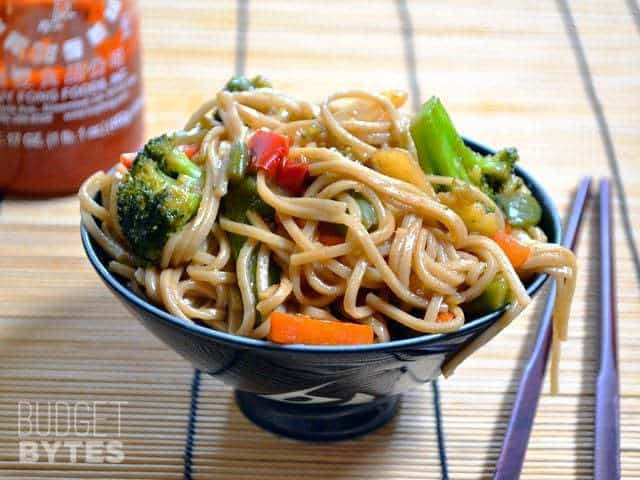
This post contains some affiliate links, which means that we make a small commission off items you purchase at no additional cost to you.
Teriyaki Noodle Bowls
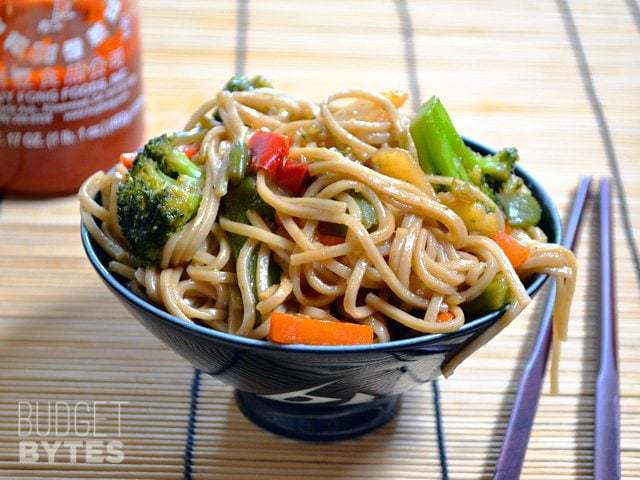
Ingredients
Teriyaki Sauce
- 1/4 cup soy sauce ($0.39)
- 2 Tbsp rice vinegar ($0.23)
- 2 Tbsp brown sugar ($0.03)
- 1/4 tsp toasted sesame oil ($0.05)
- 2 cloves garlic, minced ($0.16)
- 2 inches fresh ginger, grated ($0.21)
- pinch red pepper flakes, optional ($0.02)
- 1 Tbsp cornstarch ($0.04)
- 2 Tbsp water ($0.00)
Noodles & Vegetables
- 1 lb. frozen stir fry vegetables ($1.57)
- 8 oz. buckwheat soba noodles ($3.69)
- 1 Tbsp vegetable oil ($0.02)
Instructions
- Add the soy sauce, rice vinegar, brown sugar, toasted sesame oil, red pepper flakes, corn starch, and water to a bowl. Peel the ginger and then grate it straight into the bowl using a small holed cheese grater. If you don’t have a grater, you can mince the ginger. Mince the garlic and add it to the bowl as well. Stir to combine the ingredients.
- Bring a medium pot of water up to a boil over high heat, add the noodles, and then continue to boil for 5-6 minutes, or until the noodles are tender. Drain the noodles in a colander.
- Heat the vegetable oil in a large skillet over medium-high heat. Once the skillet is hot, add the frozen vegetables. Stir and cook for only about 2 minutes, just to slightly heat the vegetables. Briefly stir the teriyaki sauce and then pour it into the skillet. Allow it to come up to a simmer, at which point it will thicken. The vegetables will finish heating through as this happens. Turn the heat off once the sauce is hot and thick.
- Add the drained noodles to the skillet and stir until they are coated in the sauce. Divide the noodles between four bowls and then spoon any leftover vegetables from the skillet on top. Enjoy!
See how we calculate recipe costs here.
Notes
Nutrition
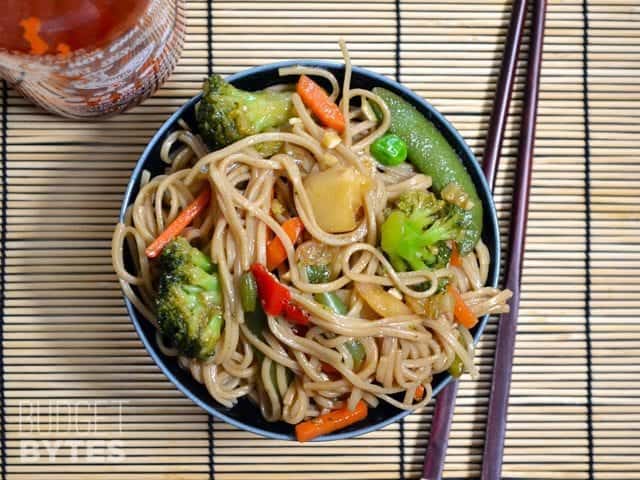
Step by Step Photos
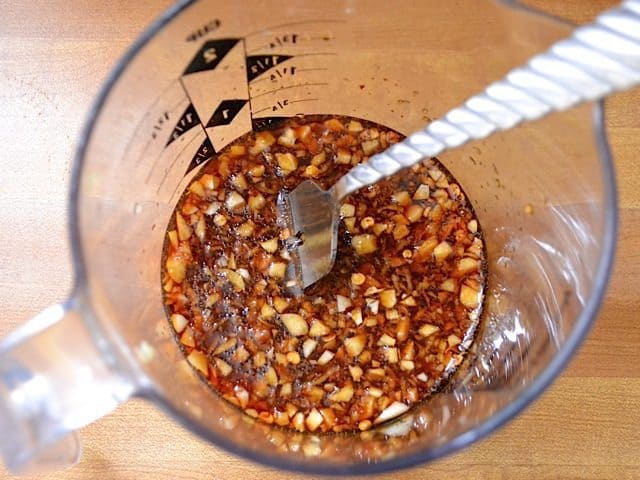
Homemade teriyaki sauce is incredibly easy to make. Just stir together the soy sauce, rice vinegar, brown sugar, sesame oil, red pepper flakes, cornstarch, and water. Grate the ginger and mince the garlic. Stir them into the sauce. (Note: this picture was before I stirred in the cornstarch. It will have a slightly milky/opaque color once the cornstarch is added).
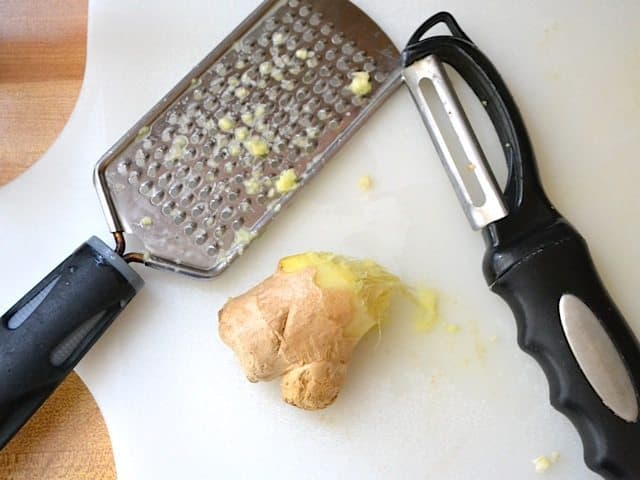
If you’ve never worked with ginger, it’s very simple. You can break off a knob the size you need at the store (just like dividing a bunch of bananas to get just a few – it’s okay). Use a vegetable peeler or the side of a spoon to scrape off the skin, then use a small holed cheese grater to grate the ginger straight into the bowl (so all the juice make it into the sauce). If you don’t have a cheese grater, you can mince the ginger.
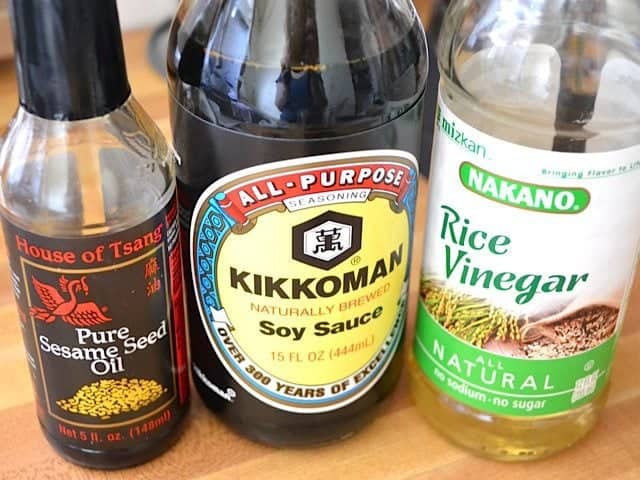
I like to keep these three things in my pantry at all times. So many different Asian sauces can be made with this trifecta. All three are extremely shelf stable and can usually be found in major grocery stores. The soy sauce and vinegar are usually very inexpensive and, while the sesame oil may be a little pricier, you only use a few drops at a time.
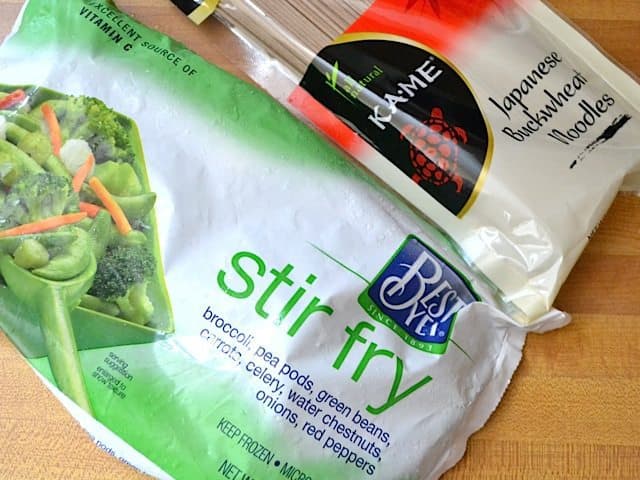
I used buckwheat soba noodles to up the nutritional value of this dish, but you can use a different type of noodle if you’d like. I definitely could have gotten a better price on the noodles if I had gone to a different store, but I paid for convenience in this case. I just bought a bag of generic stir fry vegetables and they did the trick.
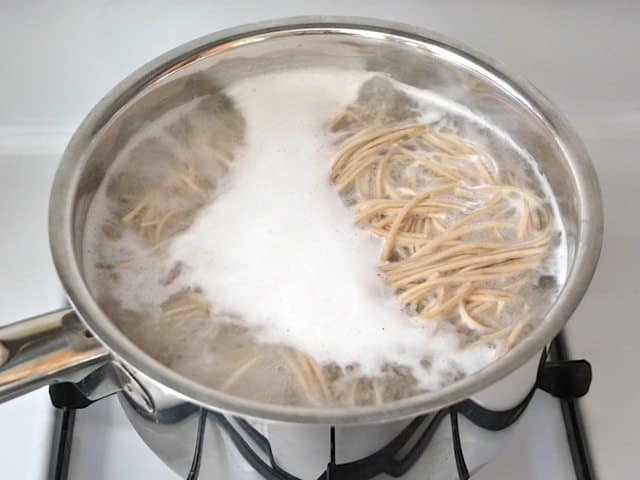
Cook the noodles according to the directions on the package (boil 5-6 minutes) and then drain them in a colander.
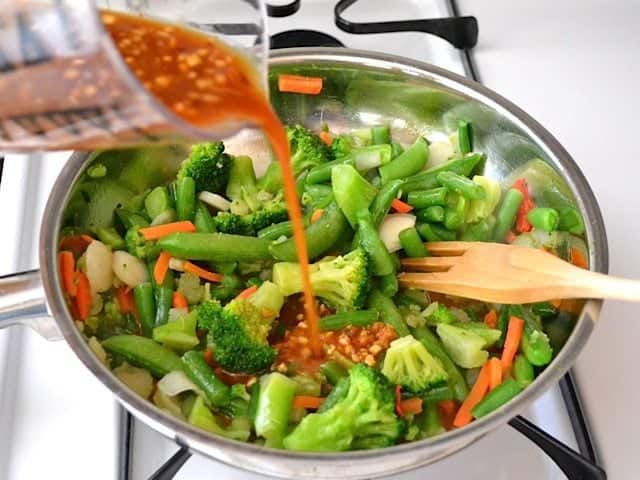
Heat the vegetable oil in a large skillet over medium-high heat. Once it’s hot, add the vegetables and cook for just one to two minutes. Frozen vegetables can be tricky because you want them to heat through without over cooking. Once the vegetables have cooked for just a short minute or two, give your teriyaki sauce a quick stir (to re-suspend the cornstarch) and then pour it into the skillet. Allow the sauce to come up to a simmer.
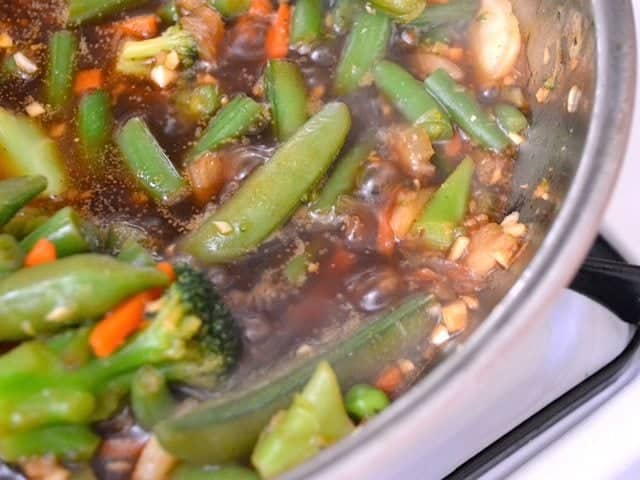
Once the sauce reaches a simmer, that’s when the cornstarch magic happens. The sauce will turn from a milky brown color to a shiny, clear, thick sauce. Taste the sauce to see if you want more soy sauce. If you want a more potent dish, you can just stir in an extra tablespoon of soy sauce. Remember, once the noodles are added the sauce will be spread more thin, so you want it to taste a little on the strong side.
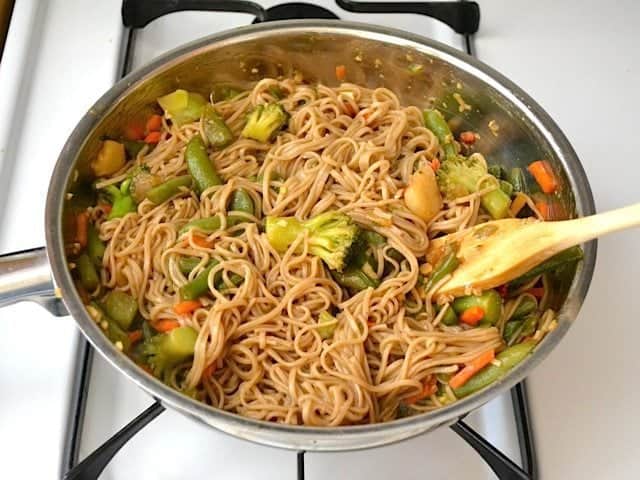
Finally, add the drained noodles and stir them in until they are well coated in sauce. In my experience, it’s pretty impossible to stir chunks of vegetables (or anything else) into long thin noodles like spaghetti. So, I just stirred until the noodles were coated and then divided the noodles between my four dishes and spooned the rest of the vegetables over top.
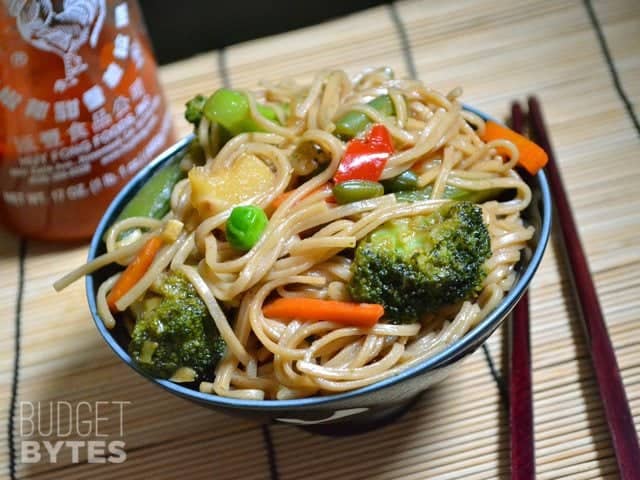
I’m going to experiment with freezing one of these bowls to see how it survives the freeze/reheat cycle. I’ll update the post tomorrow or the day after to let you know how they hold up!


This was awesome! We used a 1 lb bag of mixed frozen veg and cooked it way down and used for 2 servings. Didn’t even need the extra soy sauce. Used regular old gluten-free spaghetti. Worked great. Also added some canned mung bean sprouts to it. Thanks!
Do you think I can make this with udon noodles?
Hey! This looks delicious but just wondering can you use apple cinder vinegar instead of the rice? will It Make a huge difference?Thanks In advanced!!
Apple cider vinegar is quite a bit stronger and has a different flavor. I haven’t tried it in this recipe, but I think my first instinct would be to at least reduce the amount a little.
Thank you so much for the quick reply!! I really wanted to make this today. I’ll take ur advice then and use less!!
SO GOOD. Tastes just like those Costco bowls, I know which exact ones she is referring to. I put less than 2 inches in ginger in my recipe and it was still a little too strong in the ginger department for my liking. Will definitely make again. :D
I guess it all depends because we thought it could have used a little more! Not sure if right for others. Thanks.
My kids ate vegis! Was really good.
It’s a fast, easy recipe, though I recommend tweaking the sauce a bit. Lighten up on the vinegar, double down on the red pepper flakes, and throw in the optional extra tbsp of soy sauce. And be careful with the soba noodles – they’re atrociously easy to overcook.
I came across your blog (and this recipe specifically) by accident but I am so glad that I did! I even recently “liked” your facebook page so I could get updates with new recipes in my newsfeed.
I tried this recipe recently and absolutely loved it! Unfortunately, I had to use regular pasta noodles as I live in a small town area without easy access to specific Asian cooking ingredients. I also changed some of the included vegetables to match my personal tastes, but I followed everything else as instructed and it turned out quite well. I will definitely be making this again and look forward to trying some of your other recipes!
Thanks!
Hey all! I saw a bunch of people talking about Ginger and I had this question too so here is some helpful info
there is powdered ginger! But ratios are strange
Every 1 inch of ginger makes 4 teaspoons of (roughly) and the ‘strength’ of powder is much more potent so it needs a 4:1 ratio, for every 4 teaspoons of fresh you need 1 teaspoon of dry (spice version)
so this recipe needs 2 teaspoons of the dry ginger if you’re using that :)
I just made this for my family and it was a hit. I’ve tried several of your recipes (Oven Fajitas, Sesame Chicken, Naan bread to name a few) and they’ve all been top-notch. I appreciate that you’ve tested your recipes before posting! I feel like I can try your recipes without worrying about a disaster, or tasteless mess. Well done!
I made this last night but used the rice noodles instead, the homemade Teriyaki Sauce was amazing and so easy to make!!! I had everything for this right at home which was very nice. Will do it again!
THANK YOU! I made this for my sons tonight …. doubled the recipe and added chicken…. checking and hoping there are leftovers for lunch tomorrow… lol. (forgot to rate in my 1st comment)
This recipe was a big hit! No leftovers :( While browsing recipes I notices the sesame chicken used the same ingredients, so I made both and combined the chicken with the noodles and vegetables. Fabulous, wouldn’t change a thing.
This recipe saved our dinner the other night. It’s so easy to make. We used whole wheat thin spaghetti, since it was all we had on hand and it was still pretty good.
We did have all the ingredients for the teriyaki sauce which is the best part of this recipe.
We all loved this. Thank you for yet another 5 star recipe :D
this was so good! I threw in chicken and used a buckwheat soba that ended up a lot darker than yours once cooked, but had great flavor. Even the two year old ate it and liked it — that is SO rare here! :)